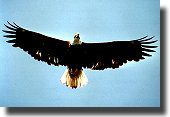|
|
Bald Eagle in flight.
Have a wing span of up to 2 metres, and can weigh 7 kilograms. This eagle has great eye sight, and can see up to 3/4 times further than can a human eye. Catches salmon when they are running on their way to the spawning grounds. A wonderful bird to see in flight, as it soars on an up current of air.
|

|
| |
|
|
Fairy Penguins parade up the beach each evening, as they return to their burrows at Phillip Island, about a 100 kilometre drive from the City of Melbourne. They are a flightless bird only 13 inches or 33 centimeters in height, but are wonderful swimmers, and can dive to 130 feet or 40 meters in search of food.
The Peguin Parade is a drawcard for visiting tourists, especially those coming to Australia from Japan.
|
![[Image]](../MoreImages/SeaBirds/FairyPenguin.jpg)
|
| |
|
|
The Boobie belongs to the same family as the Gannet. In the Galapagos Islands are three types of Boobie, the Blue Foot, The Masked, and the Red Foot Boobie. The name Boobie seems to have come from the Spanish Bobo, or Clown. These birds had a habit of landing upon ships at sea, and so were easily caught and disposed of by sailors. They are spectacular plunge divers, from 30/50 feet above the seas surface, when spotting a fish, they dive, beak down into the water, folding back their wings at the very latest moment. Then in a few minutes will reappear on the surface with their prey.
|
![[Image]](../MoreImages/SeaBirds/Boobies_2.jpg)
|
| |
|
![[Image]](../MoreImages/SeaBirds/Boobies1.jpg)
|
|
| |
|
|
Black Browed Albatross over the South Atlantic. The Albatross lives at sea, and will follow a ship, using up currents to soar aloft, and barely move its wings as it swoops and climbs, a wonderful sight to follow the movements of this graceful seabird. The Albatross needs to come ashore to mate, nest, and then teach its young to fly. Mostly found in the Southern Hemisphere, but four species do nest north of the equator.
|
![[Image]](../MoreImages/SeaBirds/BlackBrowedAlbatross.jpg)
|
| |
|
|
Osprey or Sea Eagle. Found along ocean coasts, on the shore lines of large lakes, and rivers across all continents. The female is slightly larger than the male, and has a wing span of up to 163cm. This bird catches the fish in its talons and flies back to its nest with the catch. The Osprey mates for life and a pair tend to reuse the same nest year after year. The nest is large and is always found at the top of a tree, or sometimes power poles are used.
I was able to see this wonderful seabird in action during a recent train journey in the Canadian Rockies.
|
![[Image]](../MoreImages/SeaBirds/Osprey.jpg)
|
| |
|
|
The Cormorant used for fishing in Japan. The controller of a group of these birds will tie a thin strand of twine around the neck of each bird, it is just tight enough to prevent the bird from swallowing a fish after it has been caught. A cormorant fisherman works up to 8 birds from his boat, and they can catch for him up to 80 pounds weight of fish in a day's work.
|
![[Image]](../MoreImages/SeaBirds/Cormorant.jpg)
|
| |
|
|
Emperor Penguin in Antarctia with young chick. Can grow from 20 kilograms up to 45 kilograms.
|
![[Image]](../MoreImages/SeaBirds/EmperorPenguin.jpg)
|
| |
|
|
Gulls, the cheeky, greedy feeder around our beaches, at city landfill rubbish dumps, at sporting grounds late in the day. Flocks of them arrive whenever the chance to feed appears, they are aggressive with each other, jostling like a crowd of excited schoolchildren out on an excursion. There are many different types of gull, and our coastline would be bereft without them.
|
![[Image]](../MoreImages/SeaBirds/Seagulls.jpg)
|
| |
|
|